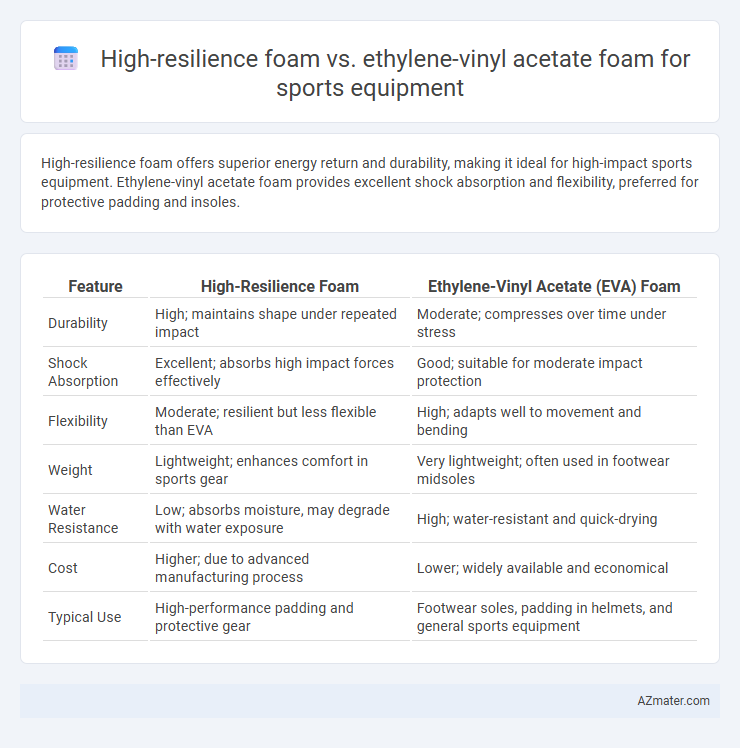High-resilience foam offers superior energy return and durability, making it ideal for high-impact sports equipment. Ethylene-vinyl acetate foam provides excellent shock absorption and flexibility, preferred for protective padding and insoles.
Table of Comparison
| Feature | High-Resilience Foam | Ethylene-Vinyl Acetate (EVA) Foam |
|---|---|---|
| Durability | High; maintains shape under repeated impact | Moderate; compresses over time under stress |
| Shock Absorption | Excellent; absorbs high impact forces effectively | Good; suitable for moderate impact protection |
| Flexibility | Moderate; resilient but less flexible than EVA | High; adapts well to movement and bending |
| Weight | Lightweight; enhances comfort in sports gear | Very lightweight; often used in footwear midsoles |
| Water Resistance | Low; absorbs moisture, may degrade with water exposure | High; water-resistant and quick-drying |
| Cost | Higher; due to advanced manufacturing process | Lower; widely available and economical |
| Typical Use | High-performance padding and protective gear | Footwear soles, padding in helmets, and general sports equipment |
Introduction to Foams in Sports Equipment
High-resilience (HR) foam and Ethylene-vinyl acetate (EVA) foam are widely used materials in sports equipment for their cushioning and shock absorption properties. HR foam offers superior energy return and durability, making it ideal for impact protection in helmets and footwear midsoles. EVA foam provides lightweight flexibility and excellent compression resistance, favored in insoles and protective padding for enhanced comfort during athletic performance.
What is High-Resilience (HR) Foam?
High-Resilience (HR) foam is a type of polyurethane foam characterized by its superior elasticity and ability to regain its original shape after compression, making it ideal for sports equipment requiring durability and shock absorption. HR foam typically features a higher density and open-cell structure, enhancing breathability and resilience during repeated impacts. Compared to Ethylene-Vinyl Acetate (EVA) foam, HR foam offers greater energy return and long-term performance, making it a preferred choice in high-performance sports padding and footwear.
Understanding Ethylene-Vinyl Acetate (EVA) Foam
Ethylene-Vinyl Acetate (EVA) foam is widely recognized for its exceptional shock absorption, flexibility, and lightweight properties, making it ideal for sports equipment such as insoles, padding, and protective gear. Compared to high-resilience foam, EVA foam offers superior water resistance and long-lasting durability, which ensures consistent performance in various environmental conditions. Its closed-cell structure also provides enhanced cushioning and impact protection, critical for athlete safety and comfort during high-impact activities.
Key Material Properties: HR Foam vs. EVA Foam
High-resilience (HR) foam offers superior energy return and durability compared to ethylene-vinyl acetate (EVA) foam, making it ideal for high-impact sports equipment requiring long-term performance. HR foam exhibits higher tensile strength and better compression set resistance, while EVA foam provides excellent cushioning and flexibility with lower density, promoting comfort and shock absorption. The choice between HR foam and EVA foam depends on prioritizing resilience and durability versus lightweight cushioning in sports gear design.
Cushioning and Impact Absorption Comparison
High-resilience foam delivers superior cushioning and impact absorption for sports equipment due to its dense cell structure and rapid energy return, enhancing athlete protection and comfort. Ethylene-vinyl acetate (EVA) foam offers moderate cushioning with good shock absorption but tends to compress more over time, reducing its long-term impact protection. The higher durability and rebound characteristics of high-resilience foam make it ideal for equipment requiring sustained cushioning and impact resistance under repeated stress.
Durability and Longevity in Sports Applications
High-resilience foam offers superior durability and bounce-back properties, making it ideal for high-impact sports equipment that requires long-lasting cushioning and shock absorption. Ethylene-vinyl acetate (EVA) foam provides excellent flexibility and water resistance but tends to compress over time, reducing its longevity under intense or repetitive use. In sports applications demanding prolonged durability and consistent performance, high-resilience foam is often preferred for maintaining structural integrity and comfort.
Weight and Flexibility Differences
High-resilience foam offers superior flexibility and lightweight properties, making it ideal for sports equipment that demands agility and comfort. Ethylene-vinyl acetate (EVA) foam is slightly heavier but provides better shock absorption and durability, which is beneficial for impact protection. The weight difference between the two affects performance, with high-resilience foam favored in applications needing rapid movement and EVA preferred for enhanced cushioning.
Cost and Manufacturing Considerations
High-resilience (HR) foam offers superior durability and energy return compared to ethylene-vinyl acetate (EVA) foam, which influences manufacturing costs by requiring specialized equipment and longer production cycles. EVA foam is generally more cost-effective due to its simpler processing methods and widespread availability, making it a preferred choice for budget-friendly sports equipment. Manufacturers must balance the higher initial investment of HR foam against its enhanced performance benefits to optimize production costs and product quality.
Environmental Impact: Sustainability and Recyclability
High-resilience foam, known for its durability and long lifespan, reduces the frequency of replacement, thereby minimizing waste generation in sports equipment. Ethylene-vinyl acetate (EVA) foam, while lightweight and flexible, poses challenges in recyclability due to its mixed polymer composition, often leading to limited end-of-life recycling options. Sustainable alternatives prioritize bio-based or recyclable variants of these foams to lower environmental impact and support circular economy initiatives in sports gear manufacturing.
Choosing the Right Foam: Which is Best for Sports Equipment?
High-resilience (HR) foam offers superior cushioning, durability, and energy return, making it ideal for sports equipment requiring impact absorption and extended use, such as protective pads and shoe insoles. Ethylene-vinyl acetate (EVA) foam provides excellent shock absorption, lightweight flexibility, and water resistance, often preferred for helmets, footwear midsoles, and padding where moisture exposure is common. Selecting the right foam depends on balancing durability, impact resistance, weight, and environmental factors to optimize performance and athlete comfort.

Infographic: High-resilience foam vs Ethylene-vinyl acetate foam for Sports equipment
 azmater.com
azmater.com